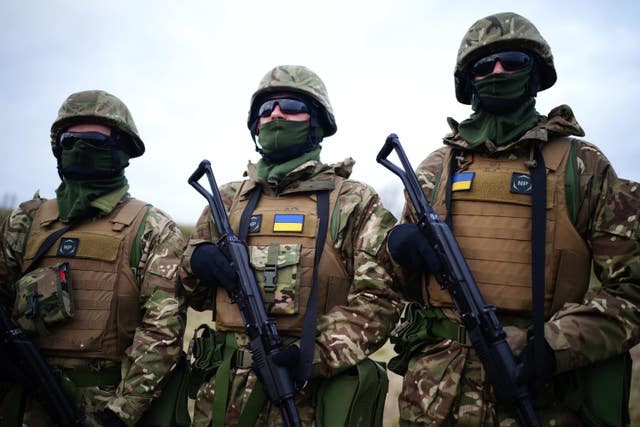Training Ukrainian troops ‘constrains’ Army’s own training programme – watchdog
British Army units saw bids for training time rejected eight times more often in 2023 than in 2019 as facilities were used to train Ukrainians.

Training Ukrainian soldiers “constrains” the UK’s ability to train its own troops, the spending watchdog has said.
A National Audit Office (NAO) investigation of British military support for Ukraine found a quarter of the Army’s training estate was being for Operation Interflex, the UK’s basic infantry training programme for Ukrainian recruits.
The use of facilities for Operation Interflex has meant British Army units saw bids for time in training areas rejected eight times more often in 2023 than they were in 2019.
In its report published on Wednesday, the NAO said: “The MoD has acknowledged that Interflex will constrain the British army’s capacity to train its own soldiers.”
Another training programme for Ukrainian marines, Operation Interforge, had to be moved to the Netherlands earlier this year because “the use of training facilities in the UK was threatening to compromise the Royal Marines’ own training needs”, the NAO added.
An MoD spokesperson said: “All UK forces have access to the relevant training required to be held at readiness to protect the UK and meet our Nato commitments.
“But we welcome the NAO’s report, which recognises that Ukrainian troops are better prepared to defend their country from Russia’s illegal invasion thanks to the UK providing training.”
More than 45,000 Ukrainians have received training in the UK since Russia’s full-scale invasion began in February 2022, with 89% of the most recent cohort telling the Ministry of Defence (MoD) it left them better prepared for the battlefield.
But there have also been criticisms of the course from Ukrainians, the NAO said, particularly regarding the lack of training on countering and using drones because of UK military and civil aviation restrictions.
Some drone training is provided, and it is understood that the MoD is looking at expanding counter-drone training within the Operation Interflex course.
Last week, Defence Secretary John Healey announced that Operation Interflex would continue throughout 2025.
Gareth Davies, the head of the NAO, said: “As the Ministry of Defence plans its future support for Ukraine, it must continue to balance the UK’s strategic interests with maintaining the UK’s own military capabilities.
“This includes making sure there are appropriate stocks of equipment and sufficient training provision for UK forces.”
Since shortly before the outbreak of war, the UK has donated £171.5 million of equipment from its own stockpiles on top of spending £2.4 billion procuring new equipment for Kyiv.

But the cost of replenishing British stockpiles is set to vastly outweigh the value of the donated equipment, with the MoD telling the NAO it expected to spend £2.71 billion up to 2030-31.
The MoD said the discrepancy was because of the UK buying newer equipment, which in some cases is more advanced than the kit donated to Ukraine.
In total, the UK has committed £7.8 billion in support for Ukraine up to March 2025, including both supplying military equipment and training Ukrainian soldiers, funded from the Treasury’s reserves rather than the MoD’s own budget.
The NAO investigation did not seek to evaluate the strategic case for supporting Ukraine or reach conclusions on value for money, but was intended only to set out the facts regarding what support was being provided.





